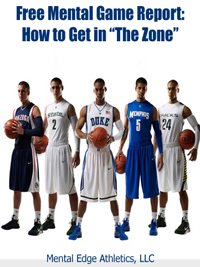 The one constant across all disciplines of competitive sport is that of stress. Athletes are continuously placed under copious amounts of stress, yet are still expected to perform at a high level. We would not be hard pressed to come up with examples of athlete who have ‘frozen’ or ‘choked’ under pressure, and have not liven up to the high expectations. Nevertheless, at the same time there are athletes whose performance is not impaired, who succeed despite the pressure all around them.
The one constant across all disciplines of competitive sport is that of stress. Athletes are continuously placed under copious amounts of stress, yet are still expected to perform at a high level. We would not be hard pressed to come up with examples of athlete who have ‘frozen’ or ‘choked’ under pressure, and have not liven up to the high expectations. Nevertheless, at the same time there are athletes whose performance is not impaired, who succeed despite the pressure all around them.
In order to help explain this difference, it has got to be understood that stress is not inherently good nor bad (Lazarus, 1993), but how an individual appraises that stress – how they view it, that is what makes the difference. The biopsychosocial model of challenge and threat (BPSM) (Blascovich, 2008), is a framework that explains how a person views stress and how it can then impact performance.
According to the BPSM, when we encounter a stressful situation an evaluation occurs in our brain, this evaluation often occurs without you even realising. It is what is known as a demand resource evaluation, where the task at hand (the demand) is weighed against what we perceive we possess (our resources). To take an example, the demand might be a basketball player shooting a free throw in a close game, and the resources that he possess is his own skill. If resources outweigh demands, we enter what is known as a challenge state, whereas if demands outweigh resources we enter a threat state. But what do these actually entail?
When we enter a challenge state, we feel that we have the resources capable to get the job done, no matter how stressful it is. As a result of this, we enter into a much more efficient cardiovascular state (ensuring greater blood flow to the brain for decision making, and the muscles for work), we interpret our anxiety much more positively and we also have boosted self-confidence, all of which helping our performance (Moore et al, 2012). However a threat state is the opposite, we end up with a much less efficient cardiovascular state, we interpret anxiety as worse than it potentially is and we also often have decreased self-confidence and performance.
Obviously then, athletes and coaches want to ensure that they are in a challenge state as much as possible, but there a few things worth considering as well. Firstly, challenge and threat states are not long lasting, that evaluation mentioned previously is constantly occurring as new information arises (Blascovich, 2008). This means that although an athlete may adopt a threat state in one aspect of performance (free throw shooting), they may enter a challenge state in a different one (when defending or dribbling). It is therefore viewing challenge and threat not as two separate states, but instead opposite ends of a spectrum, which an athlete will move across constantly throughout a game.
So how then we promote challenge states as much as possible? If we go back slightly, it is all about the demand resource evaluation. Therefore we can attempt to do two things, try to reduce the demands of the task or increase the perceived resources. It is going to be very difficult in attempting to reduce the demands of a task or event, as often there is very little control over them – so instead the best course would be through enhancing the resources. One way could be through increased skill practice, so that the athlete is more confident of their own abilities. Another crucial area is that of perceived social support (Hassell et al, 2011), making sure that an athlete is aware of the support surrounding them.
Challenge and threat states allow us to explain the differences we see in athletes performing under pressure. More importantly, by having an understanding of the mechanics behind it – means we can begin to design and test interventions that will hopefully enable athletes to succeed.
About the Author: Paul Antiss
I’ve just finished my undergraduates in Psychology with Exercise and Sport Science, at the University of Exeter in England. I graduated with a 1st class honours (highest you can get). Next year I am enrolled on a MSc course in Sport Psychology at the University of Exeter. My research and academic interests are focused around: stress appraisals, reappraisal and also talent identification (particularly the role of genetics).
Outside of academia, I’m the captain of the university mens basketball team.

























